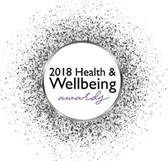|
When you first get started, there is a period of figuring out how to get to the mat regularly. Learning what sort of class suits you, and understanding the format of the class and what the teacher is talking about.
Then you start to figure out how to get into some basic postural forms, discover what the breath is doing. discover how to focus and pay attention. The teacher provides helpful feedback to help guide you into safe and effective practice. As the practice becomes more familiar perhaps we can then independently start to listen to our own cues and tune in to more subtle aspects. The guidance of the teacher is part of the picture, your own internal guidance perhaps starts to be of more importance. Some practice styles prioritise teacher feedback, others tend to prioritise students tuning in to their own feedback. Our own feedback may be more subtle and easier to miss until we become more sensitive in our practice. A teacher can never know what you are feeling in the same way that you can. At first you might have no idea how your feeling, but that sensitivity gradually develops. Your body might need to start grumbling more before it is listened to by you. The breath might get lost or become agitated or we might become out of breath before we listen to it. Sometimes students ask me for adjustments and may be disappointed when I suggest that their pose is in a good place, and offer cues to help them feel for themselves. Often people like to be told what to do (or perhaps they are used to being told what to do). Your body and breath are great guides, along with pausing to notice or taking more time in your practice to understand the responses being offered. Pausing during our practice, rather than just at the end, to observe moments of stillness and quietness, may seem counter intuitive if it isn't something your used to. Pausing, sometimes after each pose, can help us reduce our tendency to rush and not pay close attention. Some people take to it like ducks to water, moments of space and quiet are why they came to the practice in the first place. Some like to feel heat and intensity of a challenging practice with a strong focus to support and stabilise them. A long savasana at the end, once our energy is spent, may be the closest we get. Understanding your own practice can be your greatest teacher in yoga. Understanding the body and the breath, and ultimately understanding the mind and more subtle aspects beyond can be revelatory. A teacher / guide can be of enormous help and point things out that your not seeing and help you avoid indulging some ideas you may have about your practice. Feedback is a collaboration through relationship with your teacher, your body, your breath and the fruits of your practice.
0 Comments
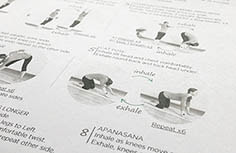 Are you good at yoga? Are you doing yoga wrong? Is there a body position you struggle against? Is there a breath technique which feels hard? Who made up the rules of yoga anyway? Rules are made up by peopleRules are made up by people. They are guidelines that probably helped someone (or many people) to gain more from their yoga practice, and so they keep being repeated and enforced in the hope that they will help you too. They are often from a book and you don't really know if the person who wrote the book would stick to that rule if they knew what happened with you when you tried to follow it. Or the rule might simply be from a bossy person who likes to tell people what to do. I do this to my kids quite often, enforce rules and boundaries, sometimes I'll seem bossy. And this has its place. Sometimes they just need to know where to start, and what to do, and how to do it. It is a good place to begin for them, and they like rules ... at first. But at some point there is a conversation about the rule, when they are ready or when they feel like that rule isn't a great idea, and the rule may well be due for an update as a result of the discussion. Or they may just need to understand what underpins the rule helps it make more sense to them. When to break the rulesRules are there to be helpful. But rules are also there to be broken / updated / changed when they aren't working.
If you come up against a rule in yoga, use it as a springboard for your own enquiry into what it does for you, or what it doesn't do for you. This doesn't give you free reign to do what you like, discipline is a powerful tool in yoga and one that I have high regard for. This is where teachers are really helpful. Someone more experienced at understanding this rule than you, with whom you can discuss it. Explore why the rule would be a helpful one for you to work with (or not). What might the rule offer that your not seeing from your viewpoint. Be prepared for an outcome either way, or if the teacher doesn't know why the rule is there, and isn't able to explore it with you, then find someone more experienced who is. Perhaps the rule is generally a good idea, or perhaps the insight you gain from the conversation and enquiry is perhaps more beneficial than the rule itself. 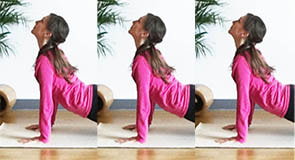 Some approaches to yoga teach the same sequence of postures and techniques that you learn, practice, develop, progress and refine over many years (e.g. Ashtanga Vinyasa). Some yoga teachers change what is taught in every class (e.g. Vinyasa Flow can get very creative). There are benefits and pitfalls to each and of course it doesn't need to be one or the other ... I teach a midline in my group classes, but with a definite pointer towards repetition and familiarity of postures, breathwork and technique. Hopefully leading you towards daily practice, repeating your personal home practice each day without variation unless there is a specific reason to adapt it. Group yoga classesMy group classes follow a term of more or less the same practice - that is several weeks of the same class. There is some development of the poses over time, exploring variations or subtleties within the poses as they become increasingly familiar. Repetition in this way helps you move beyond the excitement of 'what are we going to do today?' to allow you to become more deeply involved in what and indeed how to practice and enable you to refine what you are doing and perhaps discover more subtlety and more spaciousness in the practice. Rather than inviting in exploration of what is new and exciting, removing the novelty to leave space for other aspects to emerge. Pros and consVarying what is taught every couple of months supports you to encounter new postures, techniques and ways of practicing, learn how to do them in ways that suit you, and perhaps even discover that they are valuable to you and perhaps include in your own home practice.
Creative practice can be exhilarating and entertaining. Trying new things, exploring your body and breath, capturing your attention in new ways. This is particularly important for younger people who need the variety to keep them engaged and to keep them coming back to the practice. It can be satisfying in a way that is hugely important when you are embarking on your journey and need external motivation to keep going. I practice almost the same thing every morning. However as with all elements in viniyoga, it is about picking the right tool for the job and teaching what is beneficial and appropriate to the person wanting to practice yoga. What do you think? Breathing well in yoga can seem tricky As a beginner to yoga, it can seem difficult to keep the focus on the breath. It is common to find that you’ve been holding your breath and straining in some postures. Arms and legs are just about doing what the teacher has invited you to do - but your breath, well who knows? This is particularly noticeable in a fast-paced or deeply strenuous class where the body is most dominant and anything else gets left behind as you work your way through the class. So what if my breath isn't great?Day to day we typically breath 12-15 breaths per minute. The rate, depth and quality of it can help adjust our levels of anxiety and stress, our immune system effectiveness and many more physical and mental health markers. Yoga offers profound teachings in the breath if we choose to listen that can support our health, wellbeing and awareness in our day to day lives. Familiarity helps to develop our breath focusGradually, with familiarity of a regular yoga practice, we can start to remember to breathe with a flowing and calmer breath. And eventually the breath and movements start to link together more. From here we can start to take that further still and refine into a more advanced yoga practice. Once you feel you are able to link the breath and movements together, then the power of the breath can really start to be harnessed and the refinement and quality of our yoga practice can bloom. Our nervous system will feel immense benefit from working skilfully with breath centring and we can move beyond the endorphin highs of vigorous and strenuous yoga practice and move towards maturing our yoga practice. The breath powers our yoga practiceSounds obvious, of course we need to breath to power everything that we do or we’ll collapse in a heap. But it is easy to forget about the quality of our breath when distracted or physically strained. What if you eased back from the strain and found a spaciousness in the breath to develop the power of your yoga practice instead? What would that feel like? What could it do to your yoga practice? What if we found our physical alignment from our breath?We often listen to the technical instruction from the yoga teacher: move your foot here, rotate your hip there, etc... Breath-centred practice can support us to more naturally open and expand your body into a posture, rather than teaching instruction being the main driver. Explore how your breath can position you into a natural alignment from within that is unique to your body structure and your deepening breath. Starting out with breath-centred yoga practiceThe classes at Bristol YogaSpace work with a deeply breath-centred approach to yoga. Rather than simply coordinating with our breath, which is common in many Vinyasa, Flow or Ashtanga yoga practices, we centre ourselves in the breath more deeply and use it to power the practice and direct the postures and focus.
When I started out some 20 years ago I practiced Ashtanga yoga, a vigourous and strong yoga practice, then Iyengar yoga which is technical and detailed in its formal postures. But I eventually discovered a truly breath-centred approach in Viniyoga and practice was transformed for me. Perhaps ask your teacher more about the breath when you feel ready or curious or come along to a Viniyoga class which specialises in breath-centred yoga practice, or a yoga workshop to support you to develop more breath centring in your yoga practice. Enjoy your yoga practice. “Without breath, it isn’t yoga – it is like a river without water” Krishnamacharya 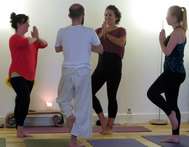 Yoga classes have begun to polarise. From the fast and sweaty vinyasa flow and Ashtanga yoga, to the restorative and Yin yoga classes that have emerged. They seem to be on two ends of a wide spectrum of modern postural yoga classes. People turn to yoga for a range of different reasons. Perhaps you've come to it to feel stronger or more flexible, or you enjoy the heat and sweat that it can build. Perhaps you enjoy the stillness and calm that it offers, or the good nights sleep it gains you. You may have an injury or pain that you are looking to sort out, or perhaps you just want that elusive feeling of wellbeing. They are all good reasons to practice yoga, and finding the right approach for your practice is more than just the immediate feeling it leaves you with. Your practice should leave you feeling better than when you started, and progressively better in the long term. You may be surprised that I even need to state this. But I regularly speak to practitioners and even yoga teachers who switch between two extreme styles of yoga practice in an effort to keep themselves balanced. Taking a strong vinyasa class supplemented with a Yin or restorative class seems a simple contradiction in approach. It's nice to change pace and explore from time-to-time. But to pursue the challenge and energy which then leaves you needing restoration to enable you to continue this cycle seems worth reflecting on. It is a cycle we often undertake in life which we then replicate on our yoga mats. Yoga practice is for the long term. It should support your primary aims as well as deepening your sense of internal balance with consistent practice. The balance of yoga doesn't begin on the mat, it beings before you get there, with your intention and choice of how to practice. Back to YogaSpace Homepage 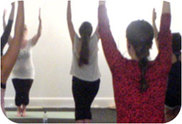 We are delighted to open our doors on Sat 13th September and invite everyone to join in our free yoga classes, meet the teachers and enjoy refreshments. We are inviting you and your friends to join us, whether you are a beginner or just want to try another style of yoga or a new teacher. Everyone is welcome! Free class schedule 11:45 - 12:45 Flow yoga with Virginie and Sheila 13:00 - 14:00 Beginners yoga with John 14:25 - 15:15 Viniyoga with Clara 15:30 - 16:30 Beginners yoga with Clara All levels of fitness and experience are welcome to all the classes. YogaSpace along with most of the other yoga studios across Bristol are all opening our doors for the 2nd Bristol Yoga Trail. Last year's was great fun so hoping to make this year's even better. Hope to see you there! See the Bristol Yoga Trail website here > Back to YogaSpace homepage > A joyful open-air yoga gathering captured on video to brighten up a dull day :-)
http://www.youtube.com/watch?v=0l7lHR8E-Lg I'm regularly asked to help people choose a Yoga class that will suit them. There are lots of styles, and flavours on offer in Bristol, so here are a few pointers and guidelines to help get you started: Please feel free to get in touch for more information. Why Yoga?Different styles of yoga offer different degrees of either physical or mental challenge and discipline or more entertainment (music etc.). What are you interested in initially? Do you want to get fit, find some calm and mental space, learn how to meditate, reduce stress, lose weight, reduce stiffness, become more grounded and centred, ease tension, aches and pains, relax more, have a physical or emotional injury that you want to improve, explore something beyond everyday life? Yoga can do all of this and more. Your personal interests will help direct which class would be most suitable. See the styles of yoga below to see where you might want to start. Try some yoga classesThere isn't really any substitute for trying the class to see if you enjoy it and get along with the teacher as it is such a personal experience. Even if your friend loves the class, it just might not suit you. Try classes out until you find one you really want to go back to. Most yoga teachers are happy for you to come along and try their class and see if it is right for you. You are much more likely to stick with it if you find a class and a teacher you are happy with. Classes vary hugely, so don't be put off from yoga if you go to a class and it wasn't what you expected or didn't enjoy it. But don't shop around forever, at some point, you should commit to a class to gain not only breadth of practice but depth to your practice. Talk to the yoga teacherEvery teacher is different and will focus their class on what they understand is important. Talk to them to see if it fits with what you are after and if they have the skills to work with any special needs you may have. All yoga teachers are passionate about what they do but not all of the have the skills or experience to guide or teach others well. Enjoy the classSounds obvious, but some people enjoy endurance and believe in the old adage 'no pain no gain'. The class should leave you feeling refreshed, revitalised, relaxed, energised, calm, settled and more positive. An overall good feeling that should speak for itself and make you want to continue. If you didn't enjoy it, or feel unwell or are in pain, feel frustrated, unsettled, uncomfortable, competitive, agitated, then perhaps the class doesn't suit you or try talking to the teacher. The effects can be accumulative so be sure it is serving you well. Feel comfortable with the teacherYou should feel comfortable in the class, and confident in the teacher so you can immerse yourself in the yoga practice. You should feel able to ask your teacher questions (before or after class usually or get his/her attention during the class) to help support you. As a beginner, or as you begin to deepen your practice and potentially encounter obstacles, a supportive and experienced teacher will help you work through these. Find a regular class and commit to itRegular practice with a teacher who you get to know, is really important to gradually develop and deepen the benefits and practice safely. Finding a yoga class that is convenient for you to get to, and is at a time that you can usually make, will give you the best chance of sticking with it. when getting started. Once you have found a class that you enjoy and are becoming regular in your practice, avoid continuing to 'shop around' for a yoga class and commit to staying at least a few months with your class (if not years!). Continuing to scoot around to lots of different classes will keep you working with great breadth and variety, but it will be at the detriment to the depth and refinement of your practice. Relaxing class or challenging class?Should you take a more challenging, intense or difficult class (either physically or mentally) or a more gentle yoga class? Or find one that is somewhere in the middle. This is where classes vary the most and finding something that suits you and suits your lifestyle is really important.. If you are relatively healthy and fit, then a more physically challenging class may suit you. If you are interested in meditation and breath focus then some classes offer physical and breath/mental challenge too, beyond just the physical aspects, and are well worth seeking out. If you already have a really busy lifestyle and are a fast-paced person, then perhaps consider exploring a more calming, supportive Yoga class that will help balance your life. You might find yourself typically attracted to a strong, intense yoga class (e.g. Bikram yoga, Vinyasa Flow yoga or Ashtanga yoga), but this might be counterproductive. After a few months/years you could find it leaves you feeling 'burnt out'. Consider trying a different approach as a counterbalance to your usual pace and lifestyle and see what happens. Stick with it, avoid being drawn by entertainment and see what hidden depths yoga can offer you. If you have an injury or medical condition, then a smaller class where the focus is on safe alignment and modifying the practice to suit each person in the class is recommended, with a well trained teacher who understands your condition. If your lifestyle is quite sedentary, perhaps your not too motivated or feel lethargic or suffer from depression, then perhaps a more uplifting and energising class to switch your pace could be helpful. Start gradually and work within your physical abilities, especially at first, and see what the results bring over the months / years. Well trained teacherYoga is a vast and ancient body of knowledge. There is much to study and as yoga teachers we are always learning more. Along with the many Yoga postures, there are many breathing techniques that are learned over time, Yoga philosophy, anatomy and physiology, and lots more besides. We recommend at least two years teacher training to even begin to get to grips with the basics and be able to teach and adapt the class safely to suit the participants. Then the teachers experience, depth of knowledge (not just breadth) and their refinement of that knowledge and skill are all important. Organisations such as the British Wheel of Yoga provide accreditation to meet this standard. (They are the only Yoga body to be approved by Sport England). Styles of yoga classHere are a few 'types' or flavours of class to help orientate you. They are all Yoga and all dealing with the same things but might feel different and focus on slightly different aspects when you try them. So this is just a rough guide, feel free to add more descriptions below in a comment to help others choose a class... ~Hatha Yoga Classes~ Classic yoga postures which also incorporate a focus on the breathing and include relaxation. Variations on postures include staying in postures, or moving into them dynamically but more slowly. Classes can range from challenging to more gentle and relaxing so try the class or check with the teacher to see what they are teaching. They usually suit all levels from beginners so good for everyone. Most YogaSpace classes are a form of Hatha Yoga. ~Viniyoga Classes~ (what I teach) Classic Yoga postures which include slow flowing movements and a close integration of breath. Generally small classes where the teacher will help adapt the postures to suit the students and will offer optional challenges as you progress. Focus on breathing and gradually deepening and developing the breath to intensify the practice when the student is ready. Good classes for all levels including beginners and working on specific goals and they are well trained teachers :-) ~Iyengar Yoga Classes~ Iyengar Yoga offers physically challenging classes where you hold classic yoga postures for a period of time to develop good strength. Strong focus on alignment, making use of equipment such as belts, blocks, bricks, chairs etc. to assist you in getting in to the posture. Less focus on breathing until a couple of years into your practice. Usually well trained teachers. ~Ashtanga Yoga Classes~ Ashtanga Yoga is a set sequence of dynamic movements which you learn over time and will work through each class. A physically demanding practice with focus on moving steadily with the breath. Physically demanding and some quite extreme yoga poses. Good level of commitment required as you need to keep this up regularly to be able to do it. Good for physical and mental stamina and an intense experience. Go carefully, especially at first. ~Bikram Yoga Classes~ Hot Yoga classes, offering a set sequence of 26 postures practiced in a hot (super-hot!) humidified room where students sweat and work hard in each pose. Often beginners will sit out some poses and just enjoy (?!) the intense heat and humidity. Teachers have learned a set class formula which Bikram Choudhury developed and has taught to all his teachers during their 9-week intensive teacher training programme. An intense experience. ~Vinyasa Flow Yoga Classes~ Dynamic movements linking poses together and flowing the movements with the breath. Often a physically challenging and focusing practice which requires some coordination to join in and keep up. Some classes are quite fast, some involve music, some are very creative and expressive, good coordination needed to practice this safely. Variable teacher training, some good but some can be trained in only a month or few months so recommend finding out. Try a class or a few classes and see how they suit you. Please add more class descriptions or suggestions below to help others in finding the right class for them.
Enjoy! Back to homepage |
More blog articles >Categories
All
Archives
July 2024
|
|
Bristol YogaSpace Ltd
Princes Place, Bishopston Just off Gloucester Road Bristol BS7 8NP |
|

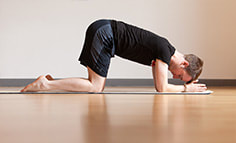
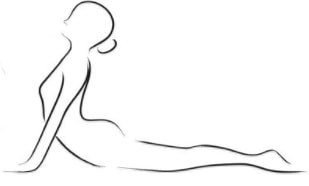
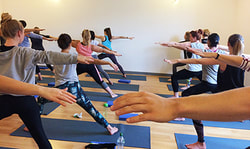

 RSS Feed
RSS Feed

